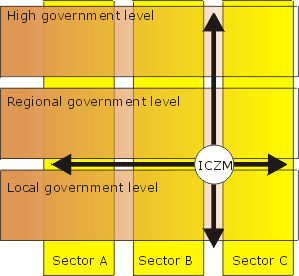Types of integration
Usually, a distinction is made between several types management integration:
- Intergovernmental integration: e.g., local,
provincial and national government levels. This is
also called "vertical integration". This integration
has the objective to harmonize policy development
by national and the final implementation by the local
governments.
- Intersectoral integration: e.g., the Ministry
of Public Works, the Ministry of spatial planning
and the Ministry of Tourism. This is also called "horizontal
integration". A specific type is called integration
in space, as the land and sea side of the coastal
zone are traditionally governed by different sectors
(e.g. tourism vs. fishery), but activities at either
side influences the other.
- Integration of governmental and non-governmental
organizations: e.g., local government, local nature
organizations and small industries.
- Integration of science and management: Clearly,
social, nature and engineering sciences have the task
to inform coastal and ocean managers. However, their
communication is often not optimal.
- International integration: It may occur
that problem areas are cut in two by international
borders. As the effects of use of natural resources
don't know these boundaries, international co-ordination
is a prerequisite. Though, the problem might have
a regional character, it are the national governments
who play a leading role in such cases.
|
 Often, horizontal (across sectors) and vertical integration
(across levels) are regarded as dominant tasks of ICZM.
Often, horizontal (across sectors) and vertical integration
(across levels) are regarded as dominant tasks of ICZM. |